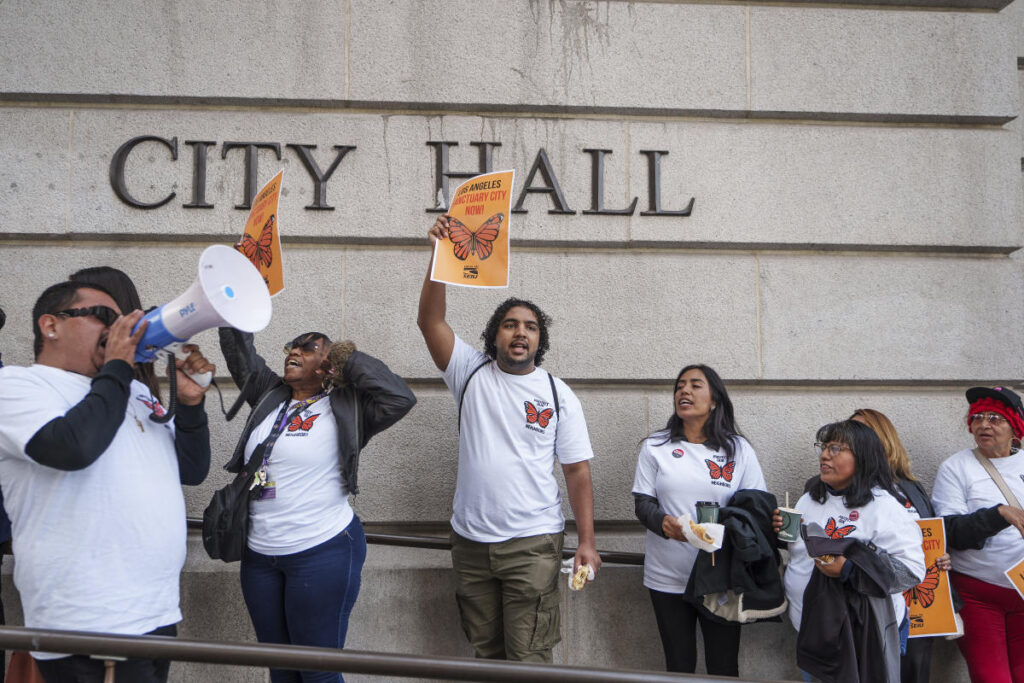On Tuesday, the Los Angeles City Council took a significant step by unanimously approving a new “sanctuary city” ordinance aimed at protecting immigrant communities amid concerns about potential mass deportations under President-elect Donald Trump. The ordinance prohibits the use of city resources for immigration enforcement and restricts city departments from sharing information about residents without legal status with federal immigration authorities. By aligning with a growing number of cities across the United States, Los Angeles is formally committing to safeguard its immigrant population and foster an environment where they can report crimes without fearing deportation. The measure will undergo a second vote as a procedural step, but Mayor Karen Bass, supportive of the ordinance, holds the veto power.
Councilmember Hugo Soto-Martinez, a key proponent of the initiative, highlighted the urgent need for the legislation given Trump’s immigration policy promises. He emphasized that the ordinance sends a clear message: Los Angeles will not cooperate with Immigration and Customs Enforcement (ICE). Soto-Martinez represents many constituents and family members who are immigrants without legal status and who contribute significantly to the community in various roles, from housekeepers to caregivers. While the council’s measure formalizes resistance to federal immigration authorities, it remains to be seen how much this will alter the existing stance, as Los Angeles has long had policies prohibiting cooperation with ICE.
The city’s current practices align with the newly codified protections; Los Angeles Police Department (LAPD) officers are already instructed not to inquire about a person’s immigration status or to make arrests based on that status. The existing executive directive from former Mayor Eric Garcetti also prioritized immigrant protections, while the state of California has enacted similar legislation. In 2017, former Governor Jerry Brown established sanctuary state laws that barred law enforcement from engaging in federal immigration issues. Under Trump’s administration, efforts were made to penalize sanctuary jurisdictions by withholding federal funding, creating tension between local and federal authorities.
The broader conversation around sanctuary policies has become increasingly complex, particularly with the influx of migrants in recent years, leading to backlashes in some Democratic-led cities. For instance, New York City Mayor Eric Adams has called for more collaboration between local law enforcement and federal immigration agencies, citing public safety concerns. In contrast, supporters of the Los Angeles ordinance rallied ahead of the council’s vote, highlighting the psychological toll on immigrant communities due to the constant threat of deportation. Advocates like Martha Arévalo of the Central American Resource Center stressed the urgency of such protections amid what they described as a climate of hate and division under Trump’s anticipated presidency.
Community members impacted by immigration policies expressed their personal fears of deportation during public statements. Jesus Carreon, a Harvard Law School student, articulated the trauma associated with living in the shadows and the urgency for protective legislation. While the ordinance aims to provide a safety net for those without legal status, some critics raised concerns about the potential for increased migration and the strain on city resources, particularly related to homelessness. Local resident Charles Brister voiced his worries that Los Angeles could become a magnet for undocumented migrants, drawing attention to the needs of American citizens struggling with homelessness.
In conclusion, Mayor Bass encapsulated the rationale behind the ordinance, asserting that immigrant protections strengthen communities and enhance the city’s overall well-being. As cities grapple with the implications of sanctuary policies amidst shifting federal immigration dynamics, the approval of the ordinance in Los Angeles signals a commitment to the principles of inclusivity and safety for vulnerable populations within the community. As these discussions evolve, the effectiveness and practical impacts of such ordinances will continue to be scrutinized, particularly in light of ongoing political pressures and public sentiment surrounding immigration issues.

